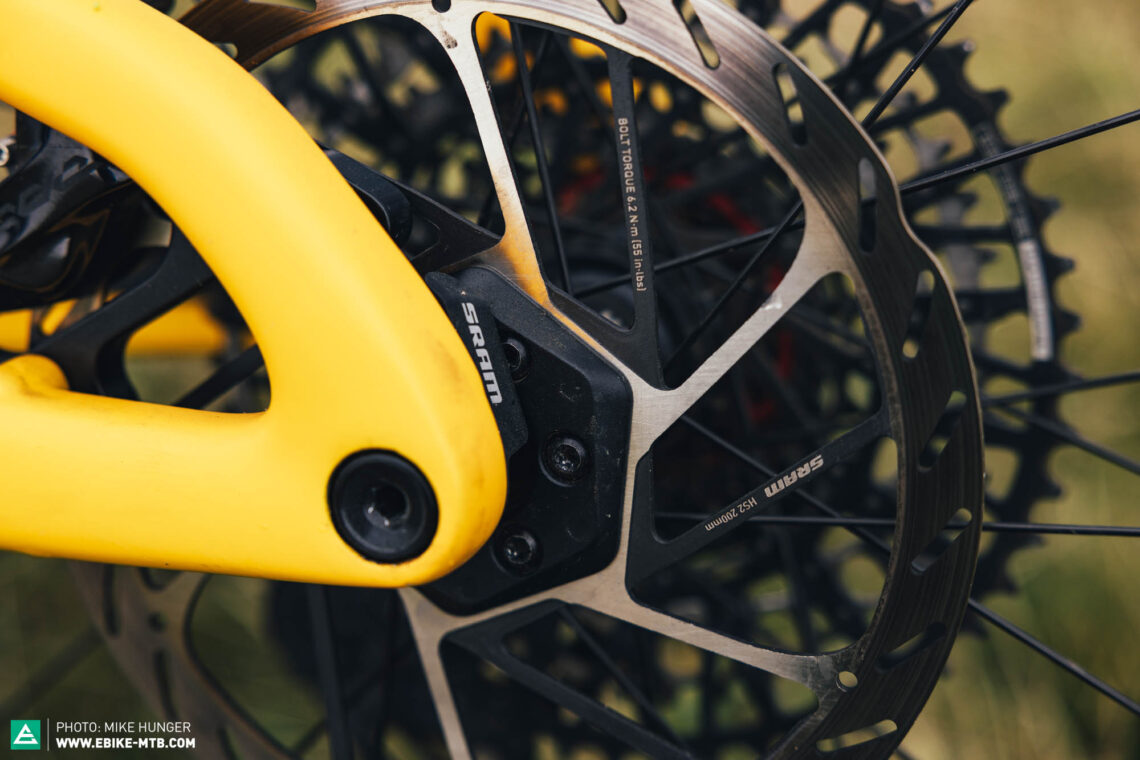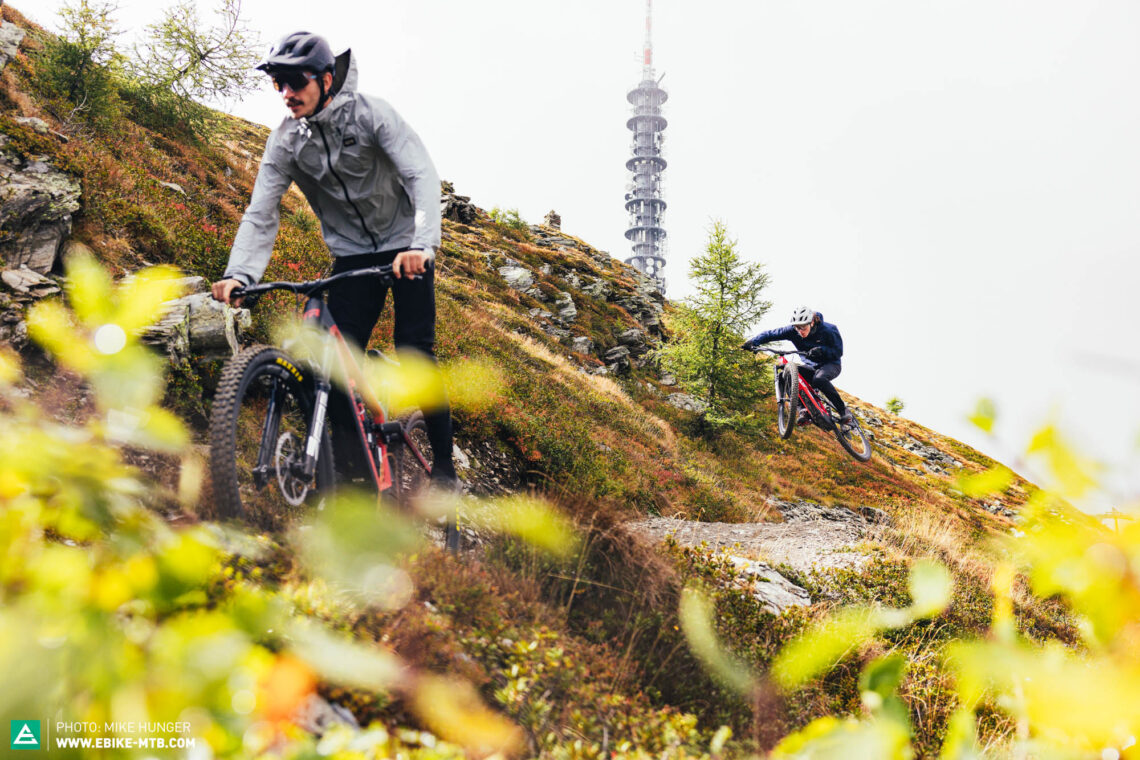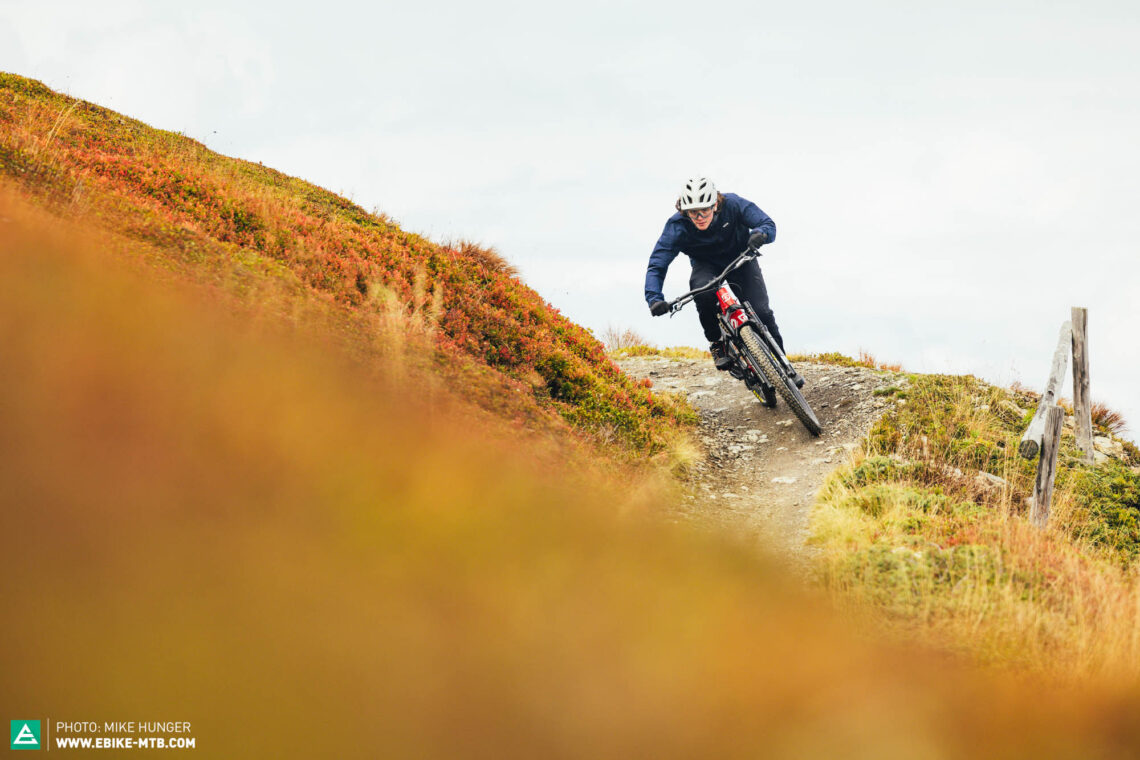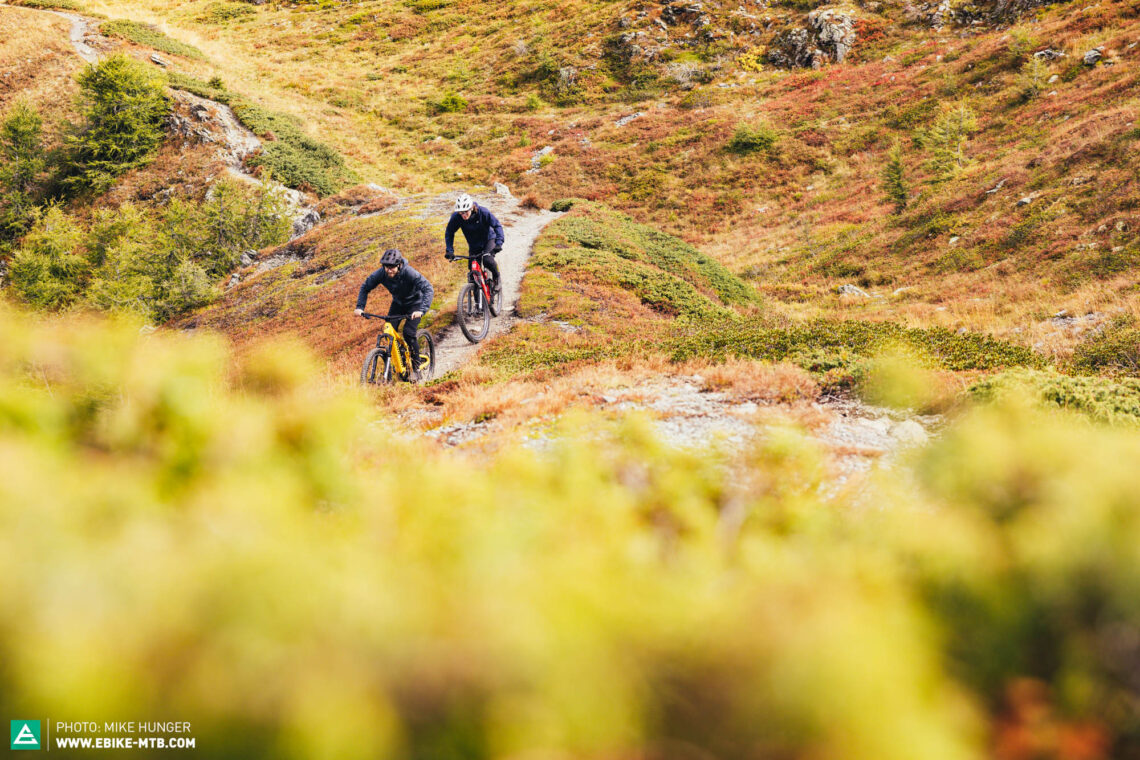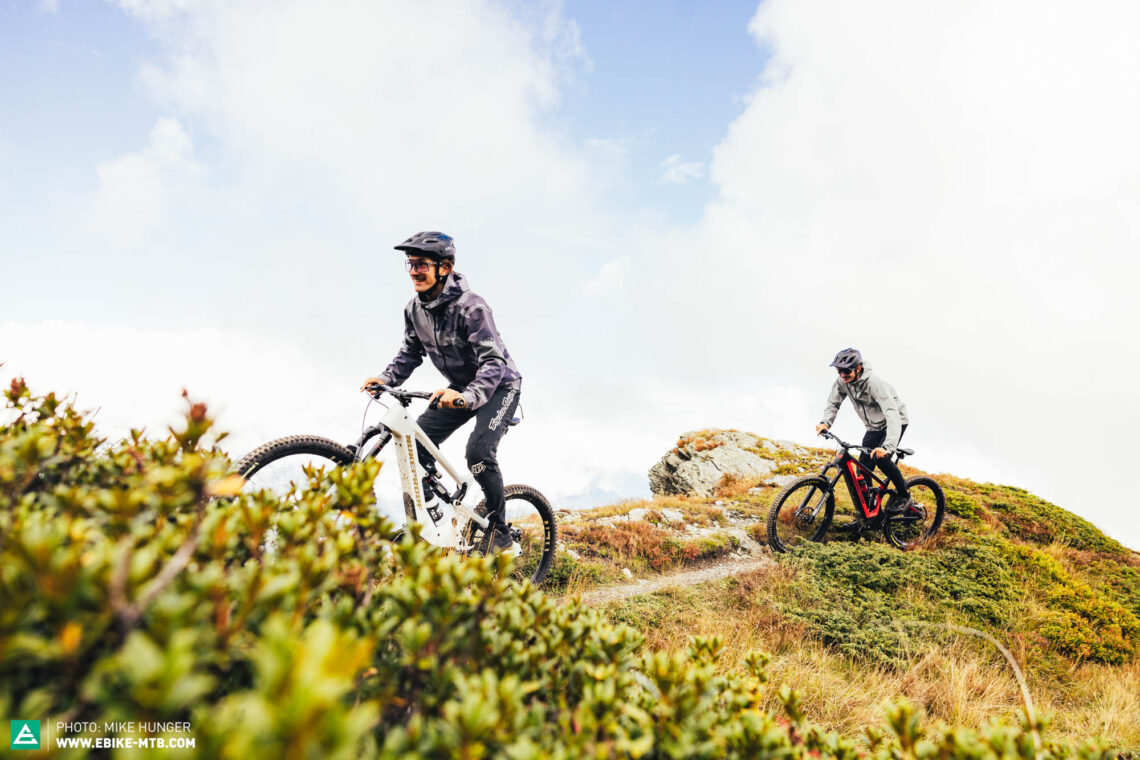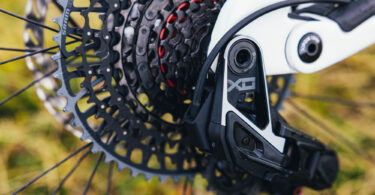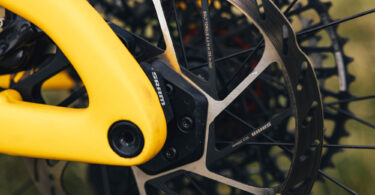An ebike motor is only as good as the bike it’s part of! This also applies to the new SRAM Eagle Powertrain system, which made its debut with four e-mountainbike brands: GASGAS, Nukeproof, Propain and Transition. But who delivered the most coherent overall concept, and which is the best eMTB with SRAM’s brand new and rather polarising motor system?
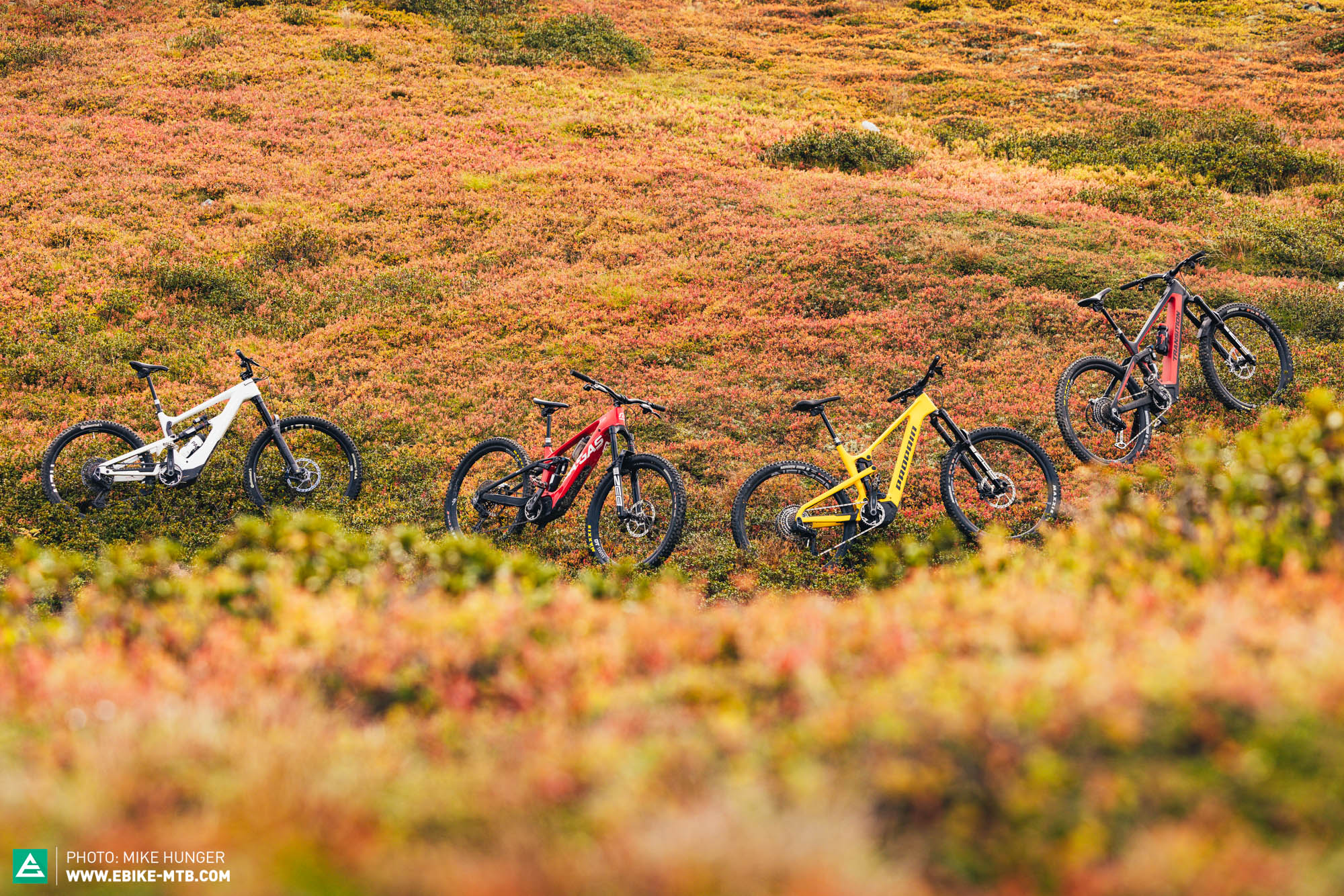
With the Eagle Powertrain, SRAM launched their first complete, in-house eMTB drive system, which includes the motor, software and Transmission drivetrain. However, the motor wasn’t developed entirely from the ground up – it’s based on the proven Brose Drive S Mag instead, which coincidentally shares similar hard numbers with SRAM’s new motor. In our in-depth review, you can find out all the details about the new SRAM Eagle Powertrain motor system.
Shortly after the release of the new motor, SRAM’s launch partners GASGAS, Nukeproof, Propain and Transition introduced four new bikes with their motor. All four bikes offer pretty much the same features of the brand-new Powertrain system, like the seamless remote integration, the Auto- and Coast Shift modes, as well as the excellent shifting performance under load. Despite sharing the same core, the four eMTBs are very different, both aesthetically and in terms of sheer numbers. The four bikes generate anywhere between 160 mm and a whopping 180 mm of travel, with a mix of both air and coil shocks. As far as wheel size goes, some are full 29ers while others rely on mixed wheel setup, with a big 29″ wheel at the front and smaller 27.5″ wheel at the rear – and one manufacturer even lets you choose between the two options! There are also major differences in terms of specs, with some brands offering just a small choice of components and others giving you plenty of freedom to build your dream bike, and this is reflected in the different price tags. Currently, if you want a bike with a SRAM Eagle Powertrain system, you’ll have to fork out at least € 7,794, while the most expensive option sets you back a hefty € 13,399. At € 5,605, that’s a huge price difference – we’ll get on to whether the price is actually justified later on.
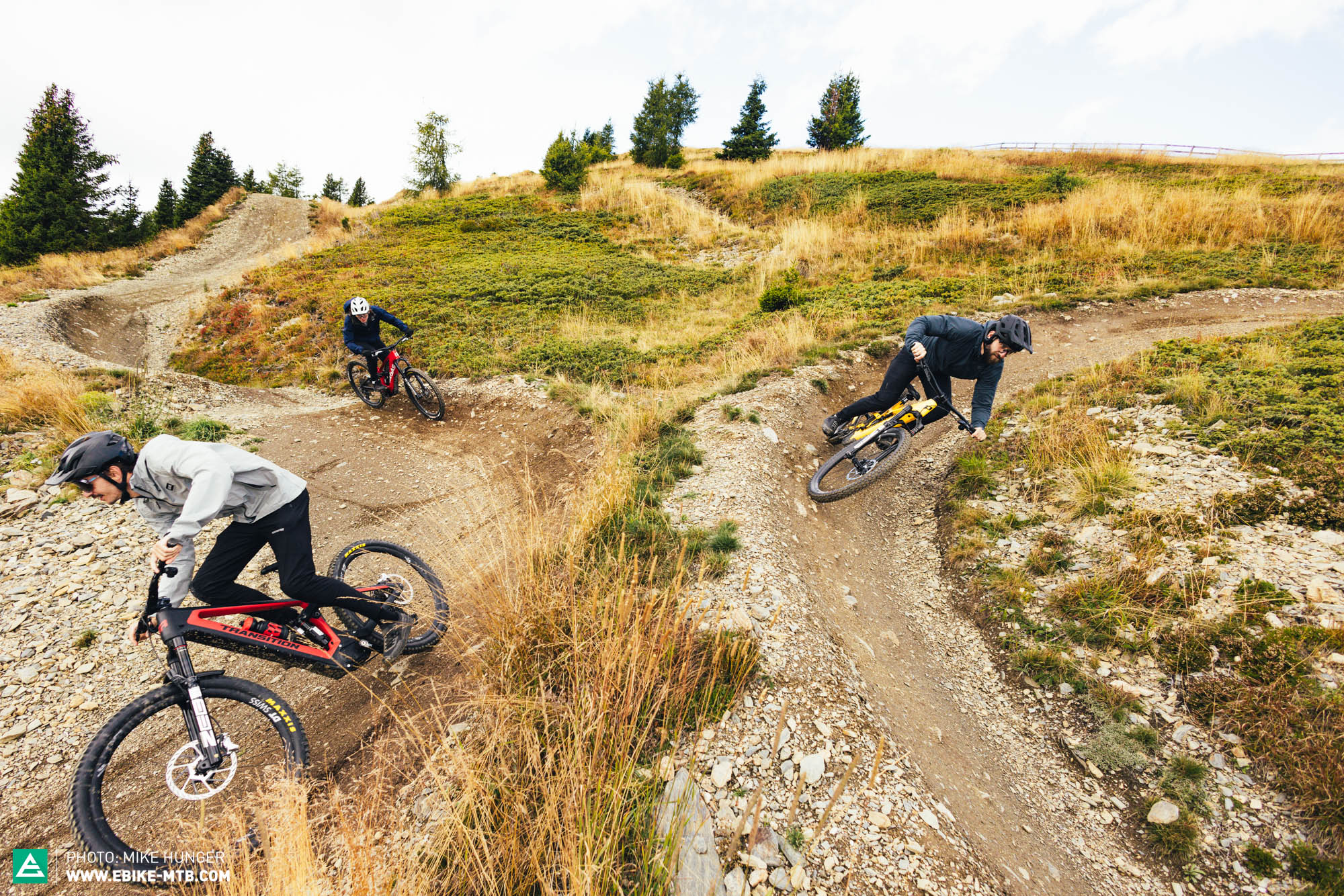
Strengths, weaknesses and potential of the SRAM Eagle Powertrain system
Sporty and downhill-oriented – that’s how SRAM are marketing their Eagle Powertrain complete system, and the bikes presented so far are all heading in this direction. Currently, the modular system only includes a few components. Apart from the motor, bike manufacturers only get the choice of one display, one remote, two riding modes and two batteries. As a result, the current SRAM ecosystem doesn’t give manufacturers as much flexibility as other eMTB drive systems, like the Bosch Smart System. Furthermore, the bulky, slightly outdated shape of the SRAM Eagle Powertrain motor poses some major integration challenges for frame designers.
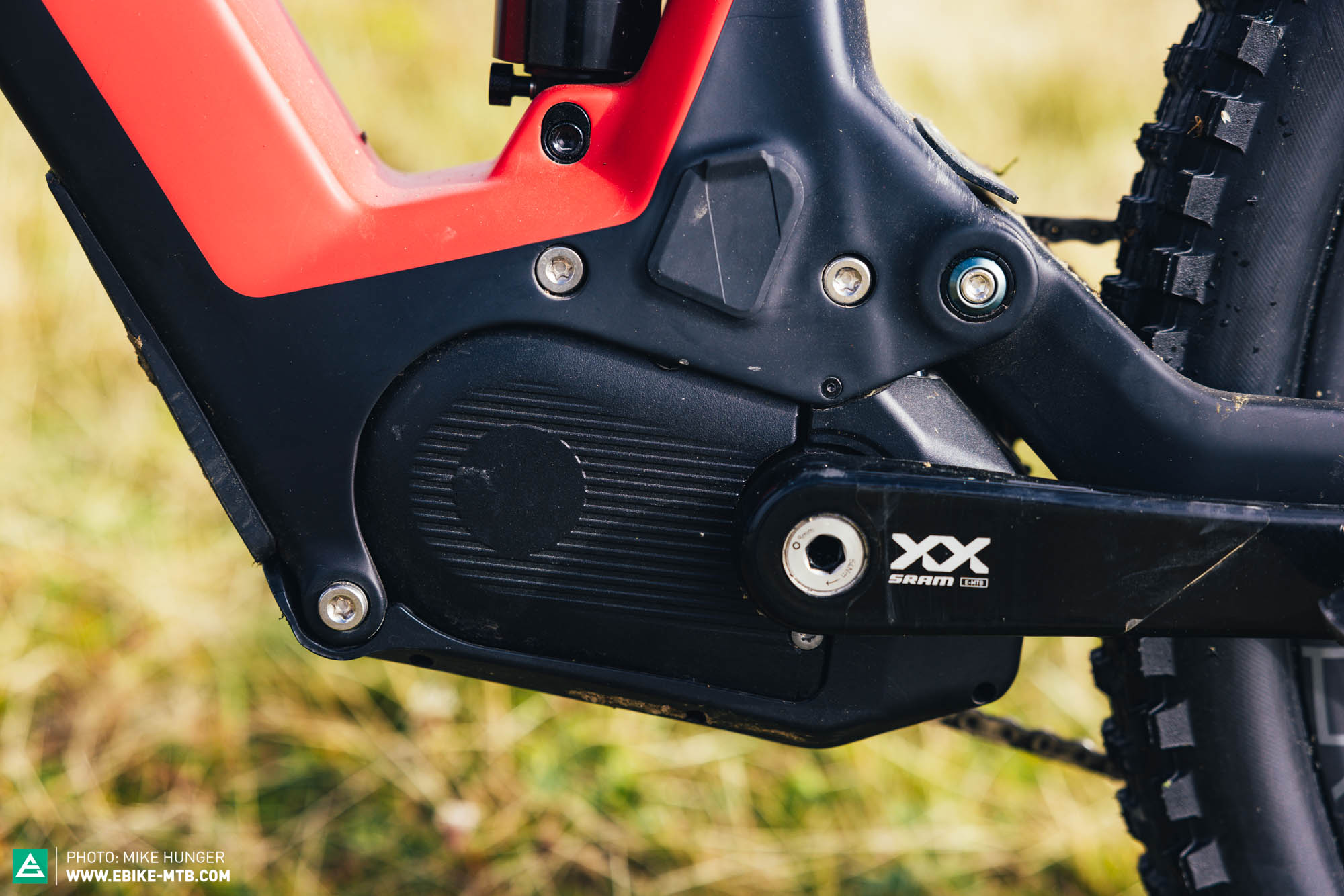
In contrast with the bulky bottom bracket area, SRAM’s wireless AXS ecosystem ensures a clean overall look. The motor doesn’t have a dedicated remote, instead being operated via two AXS Pods on the handlebars, which also double up as a drivetrain shifter and dropper post remote. While this significantly reduces the cable clutter in the cockpit, it also has a drawback: the system is only compatible with AXS components, limiting the choice of components and therefore raising prices for entry-level eMTB models sky-high. Alongside the wireless AXS integration and electronic SRAM Transmission drivetrain, the SRAM motor also includes some other interesting features. One of them is the Auto Shift function, which takes some getting used to. It isn’t like your typical automatic transmission in a car, where you no longer have to worry about shifting gears while driving. While it’s capable of dealing with a large number of scenarios on relaxed tours, when riding on technical terrain that requires you to think and shift ahead – like a descent quickly followed by a steep climb – there’s no substitute for manual shifting. For example, when building up speed before a climb by pedalling at higher cadences, the system might shift into a heavier gear. As a result, you’ll still have to do some thinking yourself and use the Override function to bypass the AutoShift function temporarily, or even deactivate it altogether to shift manually. This makes it almost impossible for sporty riders to use the automatic mode in dynamic riding situations and on technical trails, meaning that you’ll have to think for the system more than it does for you in the end. Auto Shift works better on leisurely tours with consistent pedalling cadences, where the system has more time to recognise the riding situation and adapt the gear choice. Even with Auto Shift deactivated, you can use the Coast Shift function, which brings some clear advantages to the trail, allowing you to shift into a lighter gear without pedalling – great for tight switchbacks at the bottom of climbs, or rough trails where pedal strikes are a danger.
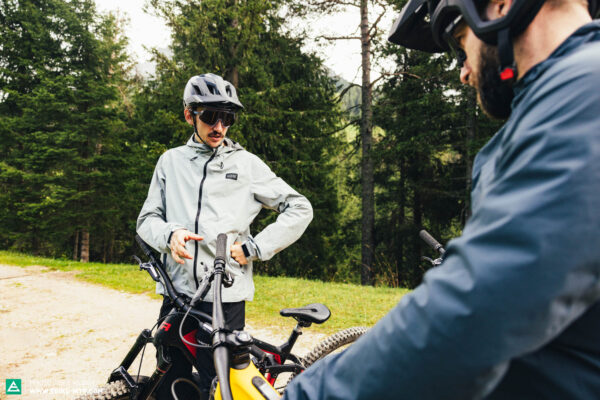
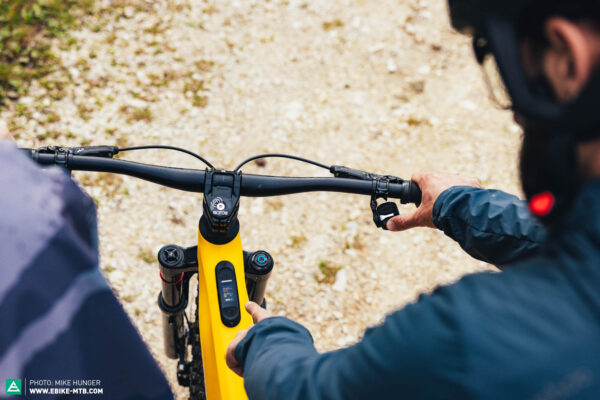
Like all digital systems, the SRAM Eagle Powertrain can be refreshed with regular software updates, which also include upgrades for the automatic SRAM Transmission drivetrain. As a result, the system is constantly evolving, both in terms of functionality and capabilities. And while all functions are cleverly bundled into the SRAM AXS app, the system still holds lots of potential. For example, you could also link a TyreWiz pressure gauge or a ShockWiz suspension tuning device to the system.
The different e-mountain bike concepts with the new SRAM Eagle Powertrain system
Despite using the same drive system, the four manufacturers offer very different interpretations of the concept, with bikes ranging from a thoroughbred eMTB racer for professional UCI e-EDR riders, to tough weekend warrior rigs and versatile all-rounders.
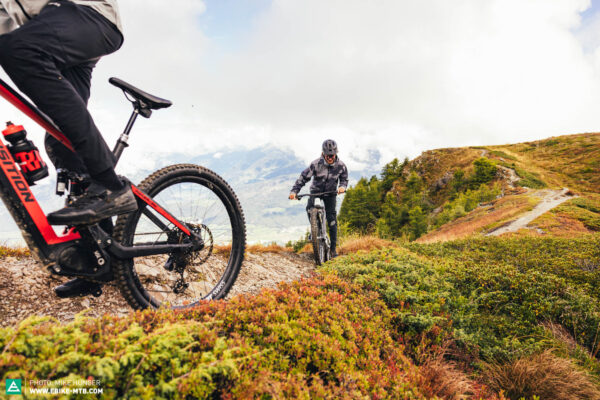
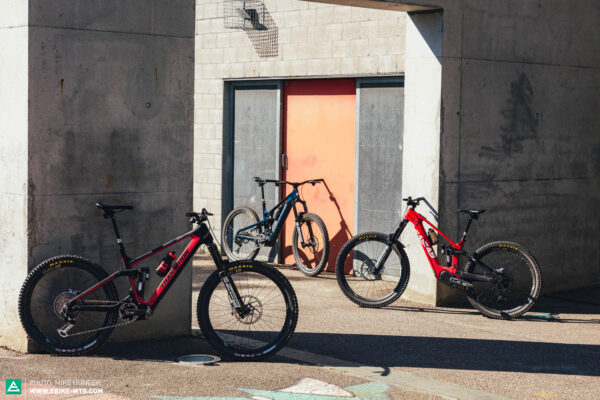
GASGAS ECC – an eMTB with MX genes
When hearing the GASGAS name, most of us will inevitably think about a bright red, 2-stroke motocross banger flying through the air. However, the Catalan manufacturer also builds ebikes, including the new ECC model, which they developed from the ground up in close collaboration with the GASGAS SRAM Racing Team with a strong focus on racing performance. The result is an aggressive looking eMTB that rolls on 29” wheels and combines 170/160 mm of travel. To keep the weight low and the handling reasonably nimble, GASGAS rely on a smaller, lighter 630 Wh battery, which is quick and easy to remove from the down tube, ensuring extra peace of mind on hectic race days while at the same time allowing weekend warriors to charge their battery at home without lugging the whole bike inside.
The ECC is available in 3 variants, with the € 7,999 ECC 4 base model opening the gateway to the GASGAS dimension. The ECC 4 is currently the only SRAM eMTB that relies on a cable operated GX drivetrain rather than the electronic Transmission version. Needless to say, this doesn’t offer the Auto Shift or Coast Shift functions, and doesn’t shift as smoothly under load, which is the biggest perk of SRAM’s Transmission drivetrain. All of the other ECC spec variants, however, come equipped with SRAM Transmission drivetrains, thus enabling both automatic and pedal-less shifting. The ECC can’t hide GASGAS’ strong MX DNA, which is clearly reflected in the bike’s aggressive look. The ECC relies on a beefy carbon frame, and just like a motocross bike, features additional plastic plates on the top and down tubes, which are meant to protect the frame against stray rocks – and the down tube protector also doubles as the battery cover. The ECC also boasts the typical, flashy moto-style branding with giant white lettering covering most of the frame. As a result, the GASGAS ECC is an excellent choice for motocross enthusiasts, while the comparatively low price makes it an affordable entry into SRAM’s Eagle Powertrain universe. True to GASGAS’ motocross roots, the motor packs a punch, yet delivers a natural ride feel, skilfully concealing erratic cadences. This comes in particularly handy when negotiating technical uphill stages in a race, but also benefits beginners. However, the Auto Shift function doesn’t make sense, especially on a race bike, because you spend too much time fighting the shifting algorithm rather than focusing on the trail ahead.
Here you can read our in-depth review of the GASGAS ECC

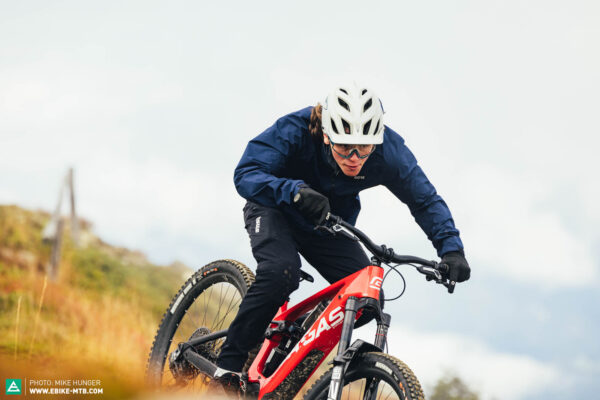

Nukeproof Megawatt Carbon RS – Tourer, shredder or both?
With the Nukeproof Megawatt Carbon, the Northern Irish manufacturer has introduced its first ever carbon eMTB. It rolls a mixed wheel setup (29″/27.5″) and, just like the Transition Repeater Powertrain, generates 170 mm of travel front and rear. The flagship RS model retails at € 11,999, while the Pro version costs € 10,499. Unlike the GASGAS ECC, all Megawatt Carbon variants come equipped with SRAM’s Transmission drivetrain with Auto Shift and Coast Shift functions as standard. For your money, you’ll get a sensible, trail-oriented spec, as well as Nukeproof’s typical boisterous DNA. The carbon frame relies on a discreet design language with clean lines, and in typical Nukeproof fashion, the shock is positioned horizontally. With its beautiful white finish, sparkling lettering and distinctive head badge, the flagship model looks extremely classy, with the only blemish being the beefy bottom bracket area typical of SRAM Eagle Powertrain bikes. The countless clever design features testify to the enormous commitment of Nukeproof’s development team.
First off, they tilted the SRAM motor slightly upwards to make way for the battery to slide out of the down tube. Another unique feature, which can’t be found on any other eMTB so far, is the storage compartment in the motor cover, which allows you to carry tools or a spare inner tube using the included strap, keeping them clean and dry – clever! Although the spec and key data speak for maximum trail performance, the Nukeproof Megawatt Carbon is far more than just a rowdy shredding machine. The intuitive handling is suitable for both beginners and experienced riders, while the excellent suspension delivers a tremendous performance on all sorts of terrain, from flowing trails to natural gnar and rough bike park lines. Outside the trail, the Nukeproof scores with outstanding all-round qualities, with the comfortable pedalling position and powerful motor also making it an excellent companion for epic backcountry expeditions. And that’s exactly where the Auto Shift function makes sense, redeeming itself from a rather shabby performance on the trail. The new Megawatt carbon is a great option for all riders who are fond of its alloy predecessor, but want more from their bike, like a bigger battery capacity, fancier carbon frame and a killer spec with SRAM’s finest components.
Here you can read our in-depth review of the Nukeproof Megawatt Carbon RS



Propain Ekano 2 CF – Tailor-made e-mountain bike?
Take a whopping 180/170 mm of travel, add a couple of juicy 29″ wheels or a spicy mullet setup, and pack it all into a carbon frame. Now choose your toppings from an extensive online configurator. This is Propain’s recipe for the new Ekano 2 CF eMTB. After launching the Ekano 2 AL alloy version last summer, the German manufacturer is following up with the Ekano 2 CF with SRAM Powertrain motor. Just like your favourite restaurant, Propain let you choose from a tasty choice of components to build your dream dish – errr… bike. Crunchy… If you want the chef to surprise you, you can choose from three 3 models, with the entry-level Base model retailing for € 7,794 – which makes it the cheapest eMTB with SRAM’s Eagle Powertrain system currently available on the market! Prices for the pre-configured flagship model start at € 11,299, and the components of all spec variants can be adapted to your needs and preferences. That said, all models share the same 630 Wh battery – like the good old pinch of salt that can’t be missing from any dish.
As with the GASGAS ECC, the battery of the Ekano can be easily removed from the down tube, and was chosen for trail performance over range, with its compact dimensions and lighter weight ensuring livelier handling. Speaking of dimensions: while the bulky motor might spoil the overall tidy look of the bike, Propain’s engineers delivered the tidiest integration of all the manufacturers in this test – after all, the presentation of a dish is important too! With its unmistakable frame silhouette and PRO10 rear suspension, the Ekano 2 CF is distinctly recognisable as a Propain and relies on a modern design language with curved lines. However, Propain’s SRAM eMTB not only convinces through its successful design, but also with its intuitive handling, which makes it an excellent option for both beginners and advanced riders. Downhill, the Propain is extremely composed, inspiring huge amounts of confidence, just like a fat kebab outside the club at 3 am! However, unlike your stomach after some dubious late-night stodge, the Ekano 2 CF is nimble and crisp, more like the fizzy can of soda you chuck down your throat to wash down the grease. The comfortable riding position enables relaxed cruising sessions, with the Auto Shift function making your life a smidge easier, provided you stick to flat, moderate trails. Alongside the Nukeproof Megawatt Carbon, it’s the best all-rounder among the SRAM eMTBs in this test, and the extensive online configurator allows you to customise the spec down to the smallest detail.
Here you can read our in-depth review of the Propain Ekano 2 CF
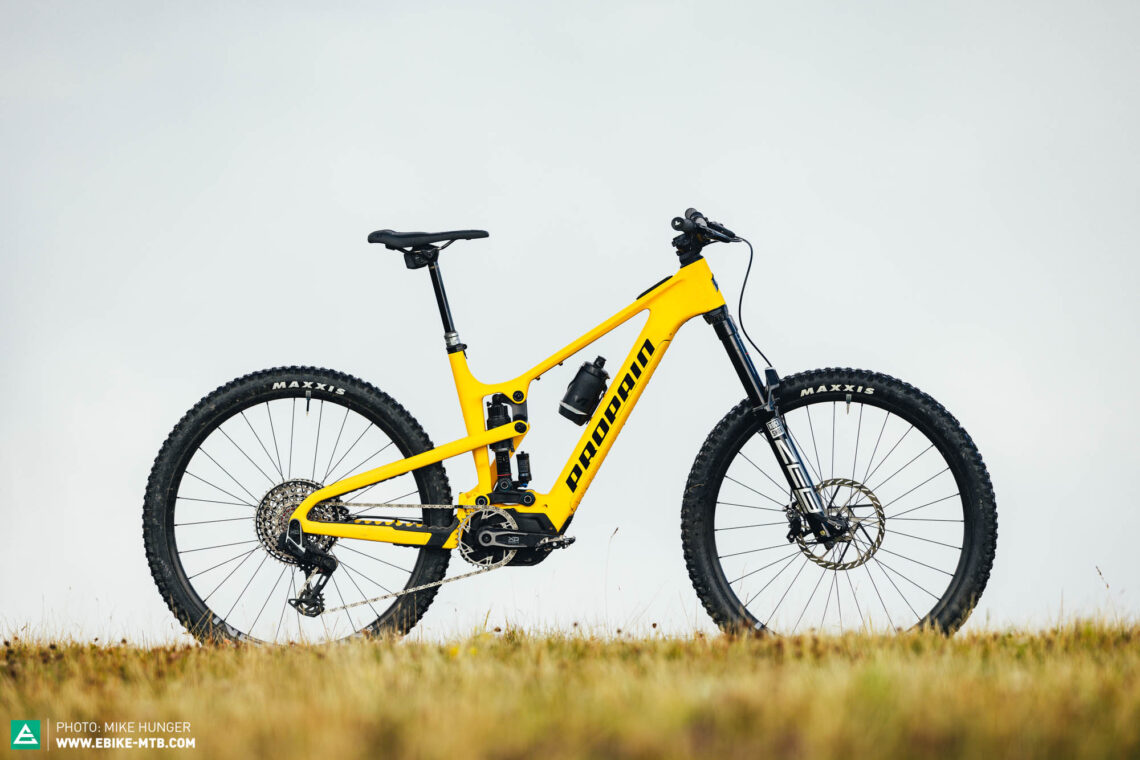
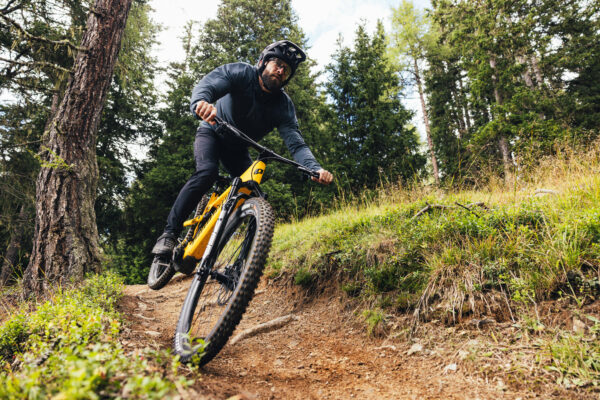

Transition Repeater Powertrain – Licenced to shred!
Transition took a little longer than most brands to switch on to ebikes, but they caught up pretty quickly. In our huge e-mountain bike comparison test, the first-generation Repeater already showed what it’s capable of, standing up against 29 of the hottest eMTBs of the season. Now the American manufacturer is following up with the new Repeater Powertrain, which relies on a carbon frame and 29″ wheels, generating 170 mm of travel. Retailing at € 11,799, the GX AXS spec variant is the most affordable version of the Repeater SRAM Eagle Powertrain, while the X0 AXS flagship model comes with an eye watering € 13,399 price tag. This makes the Transition Repeater Powertrain X0 AXS the most expensive SRAM Eagle Powertrain bike available at the moment. While for your money you’ll get a robust, gravity-oriented spec, the overall design lacks consistency. Like the Nukeproof Megawatt Carbon, the Repeater draws its power from a big 720 Wh battery: unfortunately, Transition’s developers didn’t give as much thought to integration as Nukeproof’s team, installing the battery straight into the frame without tilting the motor, which in turn positions the battery higher up in the frame, raising the centre of gravity. In purely visual terms, the Repeater struggles to deliver the same wow factor as its competitors. With its simple lines and discreet colours, the frame relies on a plain design language, which ensures an understated look, but still doesn’t make the bulky frame look any slimmer. In direct comparison with the other SRAM bikes, Transition’s integration comes across as slightly loveless, which makes the bulky motor stand out even more. On the trail, however, the Transition Repeater Powertrain inspires huge amounts of confidence, encouraging you to take your fingers off the brakes and open the tap. With its cumbersome character, it prefers to plough its way back down into the valley in a straight line rather than waste time on narrow, twisting trails. Overall, the Transition lacks the excellent all-rounder qualities of its competitors and the high centre of gravity requires a great deal of physical effort.
Here you can read our in-dept review of the Transition Repeater Powertrain X0 AXS


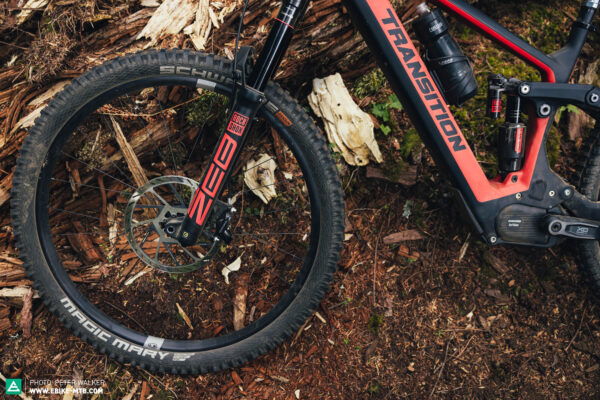
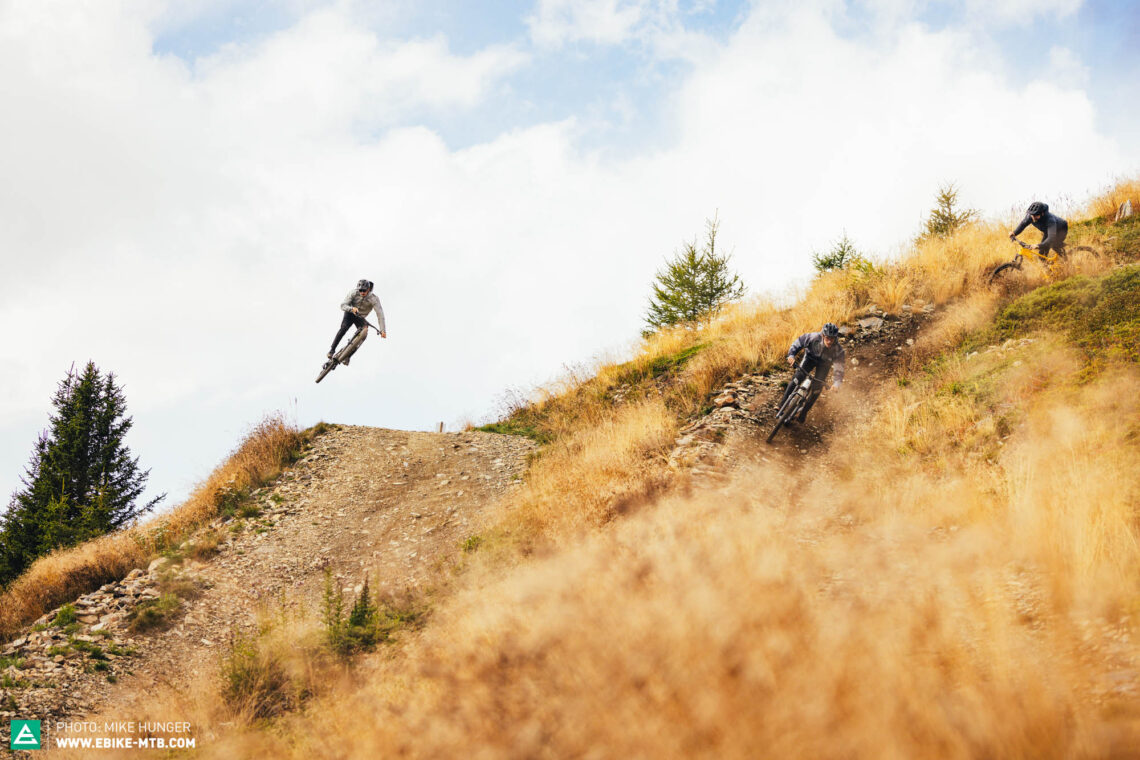
SRAM eMTB shoot out – Our conclusions
Despite looking fairly similar and sharing the same motor system, the four SRAM bikes couldn’t be more different, with the main differences being in the motor integration, aesthetics, spec customisation, range of application and price. The Propain Ekano 2 CF and Nukeproof Megawatt Carbon RS are packed with clever features and cover a wide range of applications. GASGAS score with a distinctive motocross feeling, both on the trail and with their bold aesthetics. Despite being the most expensive of the four bikes, the Transition Repeater calls for compromises, both in terms of system integration. The one thing they all have in common is the elevated entry price and the inherent inconsistency of the Auto Shift function, which reaches its limits in complex trail situations with rapid changes in cadence.
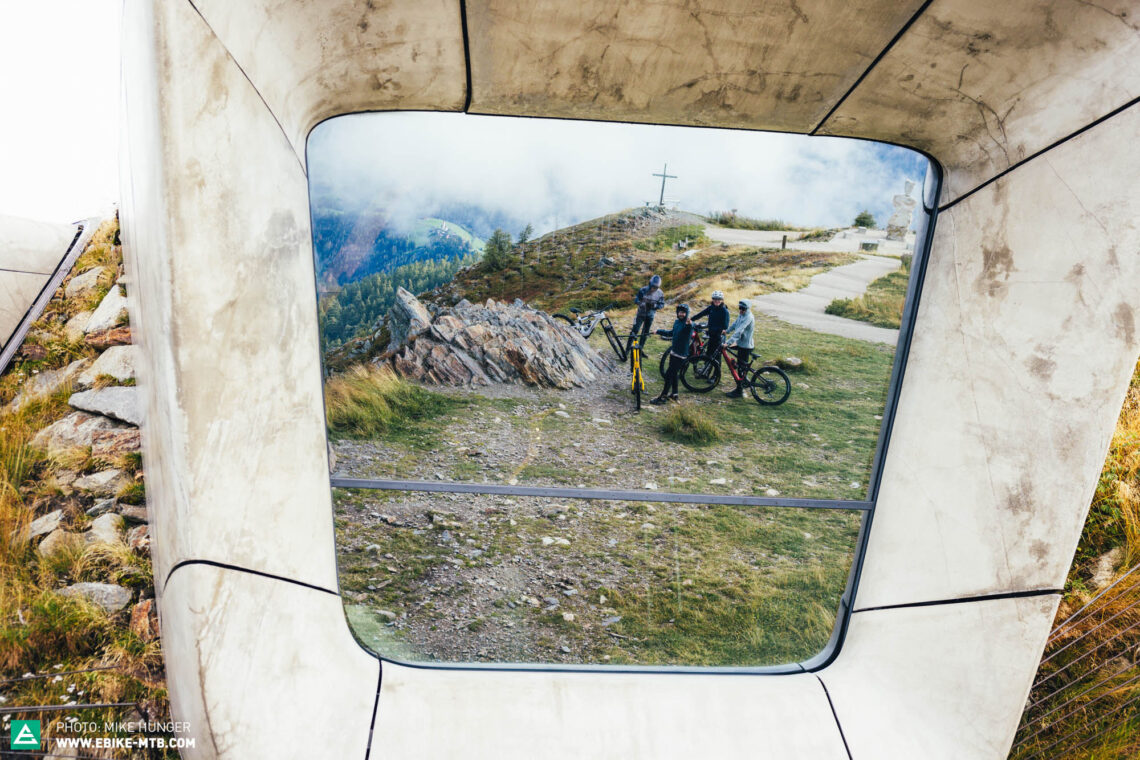
Did you enjoy this article? If so, we would be stoked if you decide to support us with a monthly contribution. By becoming a supporter of E-MOUNTAINBIKE, you will help secure a sustainable future for high-quality cycling journalism. Click here to learn more.
Words: Mike Hunger Photos: Mike Hunger






